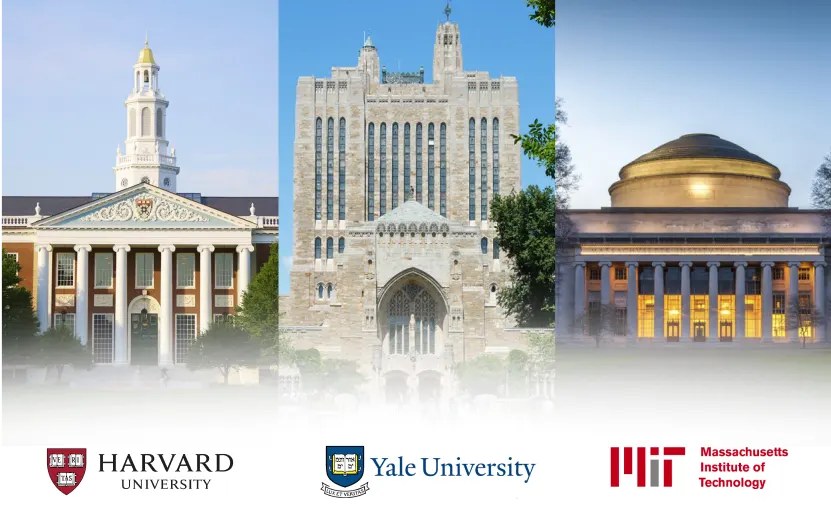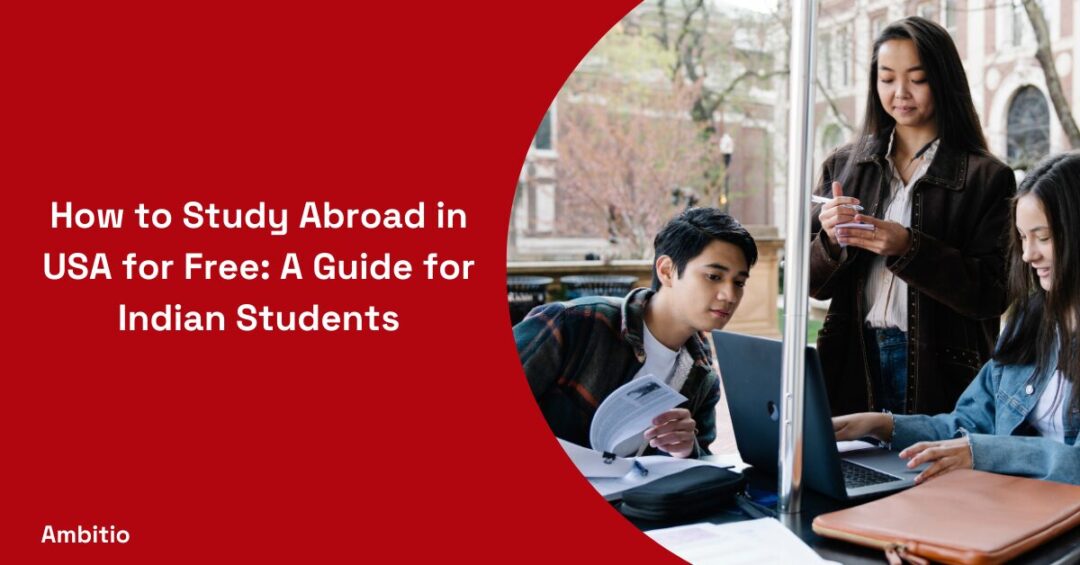14 August 2025
6 minutes read
How To Study In USA In Top Universities For Free As An International Student?

Key Takeaways
- Know how to study in USA for free through tuition-free universities, full scholarships, and smart financial aid planning
- Use top programs like Fulbright, Yale, and Stanford Knight-Hennessy that cover tuition and living expenses entirely
- Apply early with strong personal statements, letters of recommendation, and a compelling story that shows impact
$30,000 to $70,000 a year — that’s what it actually costs to study in the USA as an international student. But what if I told you some students pay zero? Not a cent in tuition. Not because they’re lucky. But because they cracked the system — legally and smartly. Yes, top universities in the USA do offer full scholarships and tuition-free education to international students. You just need to know where to look — and how to play your cards right.
I say most students drain their family savings, take huge loans, or give up entirely when they hear the tuition fee. Between visa hurdles, cost of living, and not knowing how scholarships and financial aid programs really work, the dream fades fast. But here’s the truth: colleges like Berea College, College of the Ozarks, and University of New York literally cover tuition for international students through merit-based and need-based scholarships.
Top 10 Tuition-Free Universities In The USA
Study abroad, they said. “It’ll be life-changing,” they said. What they didn’t say is that it might also bankrupt your family, give your dad hypertension, and leave you paying off loans until your grandkids start college. Welcome to the glamorous dream of studying in the USA — where international students often pay more in tuition than some Americans pay for a house. But here’s the twist nobody talks about: some universities offer free tuition even for international students in the USA.
Yes, actual free universities, no catch. They don’t advertise it in neon, but they exist — and if you’re reading this, you’re already ahead of the game. These universities aren’t just feel-good places handing out charity. They’re highly selective, offer on-campus jobs, world-class education, and expect you to give back in time, effort, and talent. Think scholarships for international students, combined with merit, need, and work-study ethics.
| University Name | Free Tuition Coverage | On-Campus Requirement | Average Graduate Salary (USD) | Eligibility Criteria (Real Talk) |
|---|---|---|---|---|
| Berea College (KY) | 100% tuition waived | Yes, mandatory 10–15 hrs/week | $42,000–$47,000 | Need-based. Only accepts students who can’t afford college. Strong academics + solid story. |
| College of the Ozarks (MO) | Full tuition for all | Yes, 15 hrs/week + 2 weeks/year | $40,000–$46,000 | U.S. work authorization required. No tuition, but you’ll work hard for it. |
| Alice Lloyd College (KY) | Free tuition for select regions | Strongly encouraged | $39,000–$45,000 | Mostly for Appalachian region students; tough for internationals but possible if already in U.S. |
| Curtis Institute of Music (PA) | 100% tuition waived for all | Not required | $60,000+ (high-tier performers) | Extremely competitive. Talent > everything else. Auditions matter more than grades. |
| Deep Springs College (CA) | Full cost of attendance covered | Yes, labor-intensive | $50,000–$55,000 | Only 26 students. Remote, intense, all-male. Transfer after 2 years. Philosophy meets farm life. |
| Webb Institute (NY) | 100% full tuition | Yes, housing provided | $80,000+ (Naval Architecture) | Only Naval Architecture. Must love engineering and the ocean. No fluff allowed. |
| U.S. Air Force Academy (CO) | Full ride (tuition + expenses) | Yes, military service required | $70,000+ starting, plus benefits | Must commit to military post-graduation. Requires U.S. residency or special sponsorships. |
| U.S. Military Academy – West Point (NY) | Tuition, room, board, all free | Mandatory | $80,000+ plus officer pay | Very limited slots for international students. Requires embassy-level nomination. |
| U.S. Naval Academy (MD) | Tuition + all costs covered | Yes | $80,000+ (Navy careers) | Same as above. Not for everyone, but an option for those with grit and discipline. |
| University of the People (Online, CA-based) | Tuition-free online degree | No campus | Varies ($30,000 avg) | Fully online. Pay only for exams. Great for working students abroad. Accepted by top companies. |
How To Study In The USA For Free As An International Student?
Education in the USA is sold like luxury real estate. The view is great, but the price tag? Absolutely ridiculous. Everyone’s preaching “study in USA for a brighter future” while casually ignoring the $40,000+ per year price tag just for tuition for international students. Add living expenses, and suddenly your “American Dream” starts looking more like a Netflix thriller. But here’s what most people won’t tell you: many universities in the USA actually offer free tuition, even to international students.
No, this isn’t clickbait. And yes, students can study without the burden of tuition — but only if they stop following the herd and start using facts.
So, if you’re an Indian student, or any other international student eyeing a U.S. degree free in the USA, here’s what you should know: there’s a system. A system filled with scholarships in the USA, tuition-free universities, and even practical training programs that can make your education free for international students. Forget what your cousin’s friend’s uncle told you. These are the five real reasons why students actually study for free in the USA — and you can too.
1. Some U.S. Universities Actually Offer Free Tuition — But Don’t Brag About It
Yes, you heard that right. A handful of elite tuition-free universities in the USA like Curtis Institute of Music, College of the Ozarks, and Berea College offer tuition-free education to every admitted student — including international students. These aren’t some shady fly-by-night schools. These are top-tier institutions that simply believe in investing in talent, not in draining families.
💡 Pro tip: These universities require students to contribute through work-study or specific service commitments. So be ready to earn your seat, not just sit in it.
2. Scholarships and Grants That Actually Cover Tuition and Living Costs
There are different types of scholarships in the USA — and most international students are only aware of half of them. While many focus on flashy merit awards, the game-changers are need-based scholarships, scholarships and grants, and scholarships to international students from private foundations, universities, and even the US Department of State (like the Fulbright program).
💡 Pro tip: Schools like Yale University and other private universities provide full merit-based and need-based scholarships that cover tuition fees, room, board, and sometimes flights.
3. Financial Aid Isn’t Just for American Students — Yes, You Can Apply Too
Most prospective students assume that only U.S. citizens can apply for financial aid. Not true. While you can’t fill out the FAFSA, many American universities have their own institutional aid applications for international students to study.
💡 Pro tip: Some universities even offer tuition-free slots specifically for graduate students or high-potential students to study abroad from developing countries. You just have to read the fine print.
4. Practical Training = Paid Work = Less Debt
Curricular Practical Training (CPT) and Optional Practical Training (OPT) aren’t just technical immigration terms — they’re golden tools that allow students can also earn a salary while studying or right after graduation. These practical training programs not only offer experience but also help you pay for tuition or living expenses.
💡 Pro tip: Choose a field of study like STEM, business, or IT — where OPT is extended, and salaries are high. Many students make back their investment (if any) within the first year of employment.
5. Applications Matter More Than You Think — Especially For Scholarships
Most international students in the USA lose out because they treat scholarship applications like regular admissions. But if you want to study for free, your letters of recommendation, personal statement, and even your resume need to scream potential.
💡 Pro tip: Tailor each application to the scholarship provider. Show leadership, impact, and purpose — not just grades. Universities may offer hidden fellowships or department-specific aid that only serious applicants find.
What Are The Available scholarships To Study In USA?
Every year, over 1.1 million international students in the USA compete for a piece of the $7.5 billion in available aid. But guess what? Thousands of scholarships go unclaimed — simply because students either didn’t know about them, thought they weren’t eligible, or didn’t bother applying. If you’re planning to study in USA, this is the moment you stop scrolling and start reading.
Below is a no-fluff, high-value table of the top scholarships — including government-funded, university-based, and private scholarships — that actually cover tuition fees, living costs, or both, making your education in the USA more affordable, or even completely free for international students.
| Scholarship Name | Covers | Who Can Apply | Offered By | Pro Tips / Notes |
|---|---|---|---|---|
| Fulbright Foreign Student Program | Full tuition, living, travel | Graduate students, researchers | US Department of State | Highly competitive; includes all fields except medicine. |
| Yale University Scholarships | Full/partial tuition + living | Undergrad & grad international students | Yale University | Offers both need-based and merit-based options. |
| Stanford Knight-Hennessy Scholars | Full tuition + stipend | Graduate students | Stanford University | Strong focus on leadership & impact. |
| AAUW International Fellowships | Tuition + living ($20K–$50K) | Female international grad students | American Association of University Women | For non-US citizen women in master’s or doctoral programs. |
| Clark Global Scholarship Program | $15,000–$25,000/year | Undergraduate international students | Clark University | Automatically considered if you apply to the university. |
| Harvard University Scholarships | Full need-based aid | UG & grad students | Harvard University | Offers extensive scholarships and financial aid packages. |
| PEO International Peace Scholarship | Up to $12,500 | Women pursuing grad degrees | PEO Sisterhood | Must return to home country post-study. |
| University of Oregon ICSP Scholarship | Partial tuition waiver | UG & grad international students | University of Oregon | Involves public service and cultural exchange. |
| Joint Japan/World Bank Scholarship | Tuition, living, travel, insurance | Grad students from developing nations | World Bank & partnering U.S. universities | For development-related programs only. |
| Illinois Wesleyan University Scholarships | $10,000–$30,000/year | High-achieving undergrads | IWU | Based on merit; renewable for 4 years. |
Conclusion
The system isn’t perfect, but if you understand how it works — and work with it — you can absolutely get a world-class education in the USA without the weight of debt hanging over your head. So don’t wait around for luck. Build your case, tell your story, and go after what’s already out there, waiting for someone like you to claim it.
To get into a top U.S. university isn’t just about grades—it’s about strategy. Ambitio’s AI-powered platform and expert consultants help you tackle applications, study gaps, and visa approvals with confidence. No confusion, no wasted time—just a clear path to your dream school. So if you want to study in USA, Ambitio is the answer.
FAQs
Can I study in the USA for free?
Yes, it is possible through scholarships, grants, tuition-free colleges, and financial aid programs that cover tuition and living expenses
Which universities in the USA are tuition-free?
Some top tuition-free US universities include Berea College, College of the Ozarks, Deep Springs College, Webb Institute, and Macaulay Honors College
What types of scholarships are available for international students?
Scholarships include merit-based, need-based, university-specific, government-sponsored (like Fulbright), and private organization scholarships
Can I work while studying to support my expenses?
Yes, F-1 visa holders can work on-campus up to 20 hours per week during semesters and full-time during breaks
Are there scholarships specifically for Indian students?
Yes, there are scholarships and fellowships like the Tata Scholarship at Cornell University and the Fulbright-Nehru Fellowship for Indian students

You can study at top universities worldwide!
Get expert tips and tricks to get into top universities with a free expert session.
Book Your Free 30-Minute Session Now! Book a call now




























